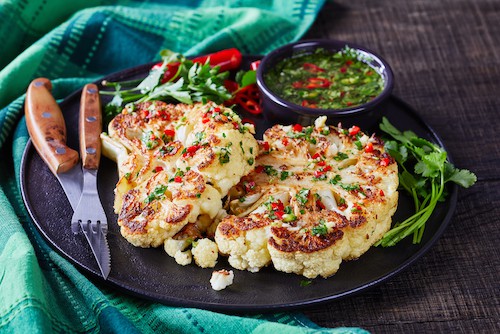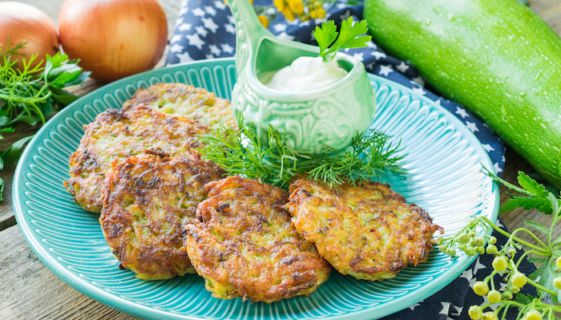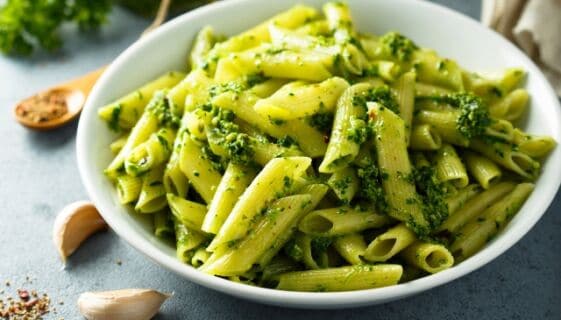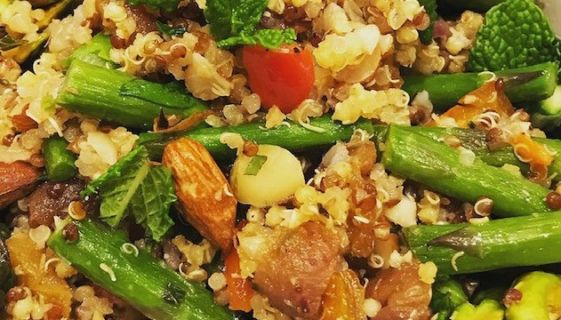The versatility of cauliflower strikes again! Our perfectly golden brown and tender cauliflower “steak” recipe is topped with a vibrant and zesty chimichurri sauce. Roasting reveals the true depth of flavor in cauliflower. The steaks are crispy on the outside and melt-in-your-mouth tender on the inside. The chimichurri sauce—packed full of herbs and garlic—adds a bright freshness. This delicious dish is loaded with beneficial properties. The power punch of fiber and anticancer elements from the cauliflower, added to the abundant phytonutrients in the chimichurri, combine to create a truly tasty way to add more anti-inflammatory and heart-healthy ingredients to your diet.
Ingredients
Cauliflower
- 1 small head cauliflower
- 1 tablespoon high heat oil (such as avocado)
- Sprinkle of salt
Chimichurri
- 1/2 cup packed Italian parsley, fresh
- 1/2 cup packed cilantro, fresh
- 1/2 cup packed kale leaves
- 1/2 cup olive oil
- 1 shallot
- 2 tablespoons vinegar (sherry, rice, or red wine)
- 2 tablespoons lemon juice
- 2 cloves garlic
- 1/2 tsp red pepper flakes
- 1/2 tsp salt
- Black pepper to taste
Directions
- Heat the oven to 400 degrees.
- Remove the large outer leaves of the cauliflower and trim a small amount of the stem to create a flat base. Cut the cauliflower in half, from rounded top to stem.
- To make each cauliflower steak, cut 1 1/2-inch thick slices that still have the stem attached. These cuts should be from rounded top to stem.
- Heat the oil in a wide oven-safe sauté pan (cast iron works well) over medium heat. Place the cauliflower steaks into the hot oil and cook until deep golden brown, about 5 minutes. It helps to occasionally move the steaks so that the oil gets underneath. Carefully flip the steaks, and then cook another 3 to 5 minutes or until the second side is well browned. As the second side browns, season the steaks with salt.
- Transfer the oven-safe pan into the oven and roast the steaks until the stems are tender and can be pierced with a fork, 12 to 15 minutes.
- If you do not have an oven-safe skillet, you can brown the steaks in a regular skillet, and then carefully transfer them to a baking sheet lined with parchment paper.
- While the steaks are cooking make the sauce either by hand or in a food processor or blender:
- Make the sauce in a food processor or blender: Add garlic and shallots to the bowl of a food processor or blender, and then pulse until minced. Add the parsley, cilantro, kale, salt and red pepper flakes. Pulse until the herbs and kale is chopped small. Scrape the sides, and then pour in the olive oil, lemon juice and vinegar. Pulse a few more times until the sauce comes together. Taste and season with more salt or pepper if needed.
- Make the sauce by hand: Mince the garlic and shallot, and then add to a medium bowl. Finely chop the herbs and kale then add to the bowl along with the salt, red pepper flakes, olive oil, lemon juice and vinegar. Stir then taste and season with more salt or pepper if needed.
- Serve cauliflower steaks with a generous spoonful of chimichurri sauce on top. For side portions, slice each steak in half and then serve.
Storing: The sauce holds well for a few days in your refrigerator and tastes delicious with steak, fish, chicken, and all other vegetables.
Nutrient Highlights
Cauliflower: A member of the Cruciferous family of vegetables, cauliflower provides a good source of dietary fiber, thiamin, riboflavin, pantothenic acid, niacin, Vitamin B-6, Vitamin C, and Vitamin K. Cauliflower is also rich in anti-inflammatory properties from phytochemicals (carotenoids, polyphenols, flavonoids, and ascorbic acid), and gut health promoting properties, due to it being a prebiotic (food for our good gut bacteria). This is one of the most nutrient-dense foods, with only 25 calories per cup, and packed full of immune and health supporting vitamins and minerals.
Parsley: Parsley is a vibrant, flowering plant that originates from the Mediterranean. It contains nutrients such as Vitamins A, C, and K, and antioxidants that help to prevent cancer. Such antioxidants are lutein, beta-carotene, and zeaxanthin, which not only are known to prevent cancer, but also can prevent age-related macular degeneration. Parsley has also been found to have antibacterial properties that may help to prevent food poisoning from bacteria such asListeria and Salmonella. Adding parsley to any dish helps to provide lots of flavor without adding many calories!
Garlic and Shallot: These vegetables are amazing prebiotics, meaning they feed the “good” bacteria in our gut and promote a healthy digestive system. Research supports that compounds such as allicin in garlic and shallots have antioxidant, anti-inflammatory, antimicrobial, and cardio-protective properties.
Kale: Low-calorie, nutrient-dense food. High in Vitamin K, rich in vitamin A, Vitamin C, excellent source of folate, non-heme iron, magnesium, and calcium. Anti-inflammatory properties from phytonutrients that can help protect the body from cell damage. Promotes gut health as it is a prebiotic (food for our good bacteria). Leafy greens have been shown to support brain functioning, lowering the risk of cognitive decline.
Lemon juice: Lemons are a versatile fruit that can be added to savory or sweet dishes. This little fruit packs a lot of bang for its buck, since it contains fiber; various beneficial plant compounds, and up to 51% of your Vitamin C needs. Lemons contain a soluble fiber called pectin, which has been found to make you feel fuller longer and improve gut health. This fruit may also help to prevent the formation of kidney stones by increasing urine volume and the pH, making it difficult for kidney stones to form.
Olive Oil: A rich source of mono-unsaturated fats, olive oil contains antioxidants and omega-3 fatty acids that exhibit anti-inflammatory effects. Olive oil also promotes gut health.



 Ananda Kaplan
Ananda Kaplan


